Affiliate disclosure: This post may contain affiliate links. Please see our Privacy Policy.
The smell of fresh lilacs is irresistible in the springtime, and homemade lilac wine captures those brief spring blossoms into a drink you can enjoy year-round.
It’s simple to make, with just a few ingredients and minimal equipment.
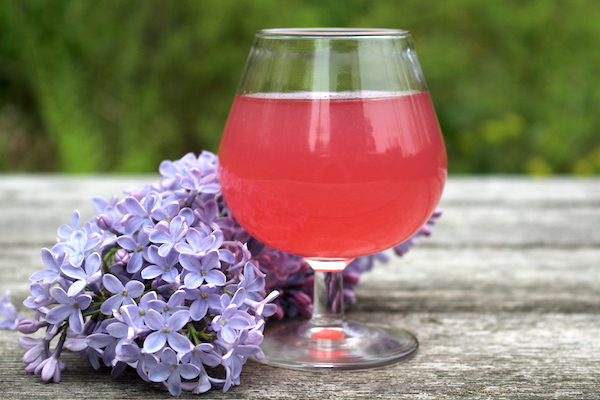
Table of Contents
Ever walk by a lilac bush and think, I wish I could bottle that and enjoy it all year? When you make lilac wine, you’re bottling both the smell and the taste of lilacs in a deliciously floral wine.
Lilacs are edible flowers, and you can make just about anything with them. I’ve made lilac donuts, which were amazing, and next on my list is lilac cheesecake. For now, lilac wine is bubbling away on the counter and the first few stolen sips have been divine.
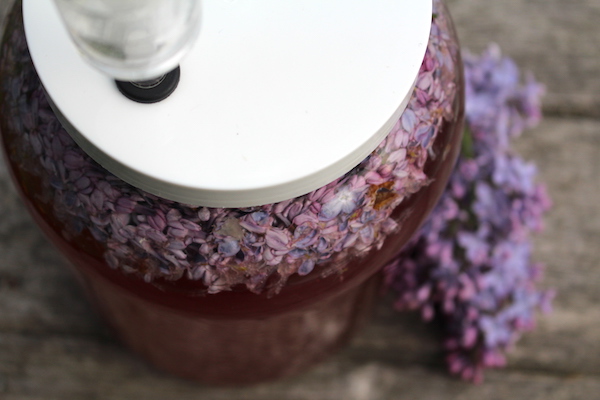
How to Make Lilac Wine
The first step to making lilac wine is harvesting lilacs. Obviously choose a clean, unsprayed location and avoid roadside bushes that are exposed to exhaust and road spray. Lilacs, in general, are a low-maintenance perennial, and they often thrive in complete neglect, sprouting up around old foundations generations after the house has collapsed.
If you’re spraying your lilacs with anything EVER, I can’t imagine the reason. But still, stick with your own homegrown lilacs or those of an organic-minded friend.
We have a big lilac bush right by our front door and it only took about 5 minutes to harvest enough blossoms for this lilac wine recipe. There’s still plenty on the bush for other lilac recipes, they’re so prolific.
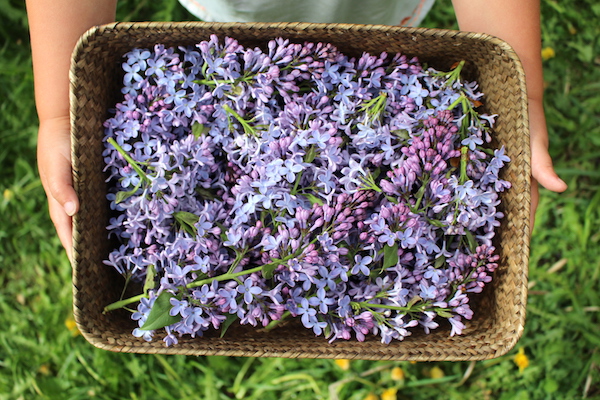
While harvesting the blossoms is quick, cleaning them takes a good bit longer. While it’s not as time-intensive as cleaning dandelions for dandelion wine, it did take about half an hour to strip off 6 cups of blossoms, removing all the stems and green parts.
I’ve seen recipes that have you make a lilac tea with boiling water, and allow it to steep for 24 to 48 hours. I’m using a different method because I want to preserve more of the volatile compounds in the lilacs, and their beautiful purple color.
Lilac tea is brown you see, and while a brown wine still tastes lovely, I wanted this brew to have a bit more magic to it. We drink with our eyes as much as our tongues.
I packed the lovely purple lilac blossoms into a wide-mouth fermentation jug because they’re going to infuse into the wine during the whole primary fermentation for 7 to 10 days. In a narrow neck fermenter, this can be a messy prospect and it’s hard to clean the blossoms out afterward.
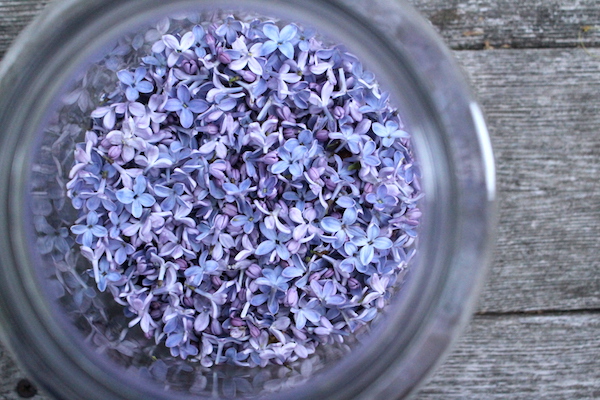
Next, I brought a few quarts of water to a boil on the stove and stirred in the sugar to dissolve it completely. I tossed in a few blueberries for color, literally 3 or 4 of them, and they turned the sugar water a glowing purple as the syrup cooled. The blueberries are optional, but they help give this lilac wine a lovely finished color.
Allow the syrup to cool completely, and then pour it over the lilac blossoms in the fermentation vessel. Next, add lemon juice, which will turn the blueberry water a bit pinker.
It’s interesting to watch, and the same color change happens when you’re making violet jelly. It starts off blue, and then as soon as the lemon juice hits it the whole thing turns a deep pink/magenta color.
Some fun kitchen chemistry, and even better color for the finished wine.
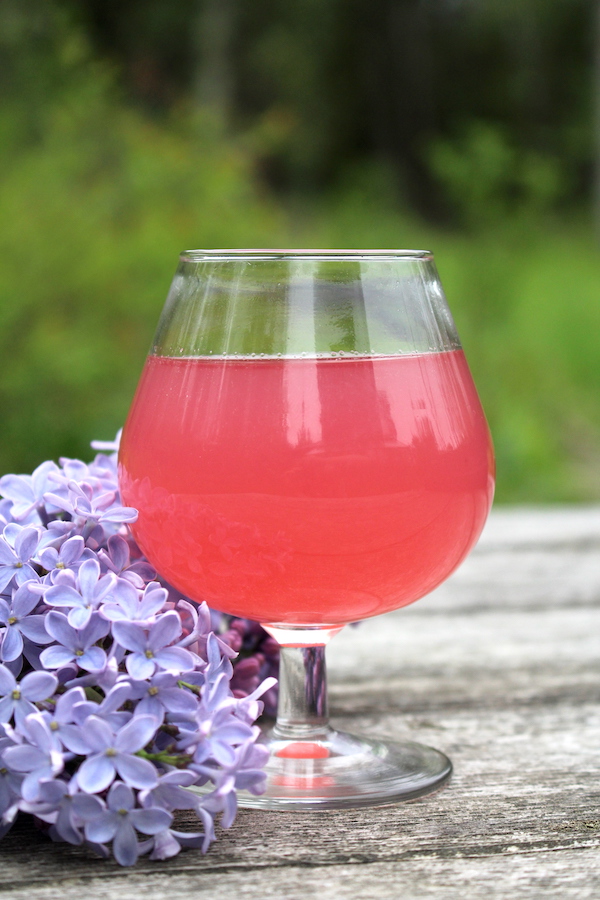
Lastly, it’s time to add a few winemaking chemicals and yeast. This recipe uses a small amount of yeast nutrient, which provides the necessary micro-nutrients to help feed the yeast. Lilac blossoms are tasty, but they’re not exactly grapes, and the yeast needs a bit more nutrition beyond sugar to thrive.
A tiny bit of tannin powder also helps to create a more balanced wine and evens out the flavors across the tongue. While the yeast nutrient is a must, the tannin powder isn’t strictly required. Generally, a small bit of tannin really improves the flavor of floral or fruit wines, and I’d suggest it.
Alternately, you can add a cup of strongly brewed black tea instead, which will add tannin instead of the tannin powder. For even more flavor, try adding a cup of earl grey, as the floral notes in the bergamot will work well in the finished lilac wine.
Allow the wine to ferment in primary, with the flowers in the fermenter, for about 7 to 10 days. During this time, keep an eye on it and make sure the lilac blossoms don’t rise up and clog the water lock. If they do, just open it up and clean it out before sealing the fermenter again.
Once the initial violent fermentation is complete, and things settle down a bit, rack the wine into a clean fermentation vessel. If you only have one, you can move it into a very clean bowl or a couple of half-gallon mason jars while you clean out your fermenter. Make sure you leave any sediment behind and filter out the lilac blossoms at this point.
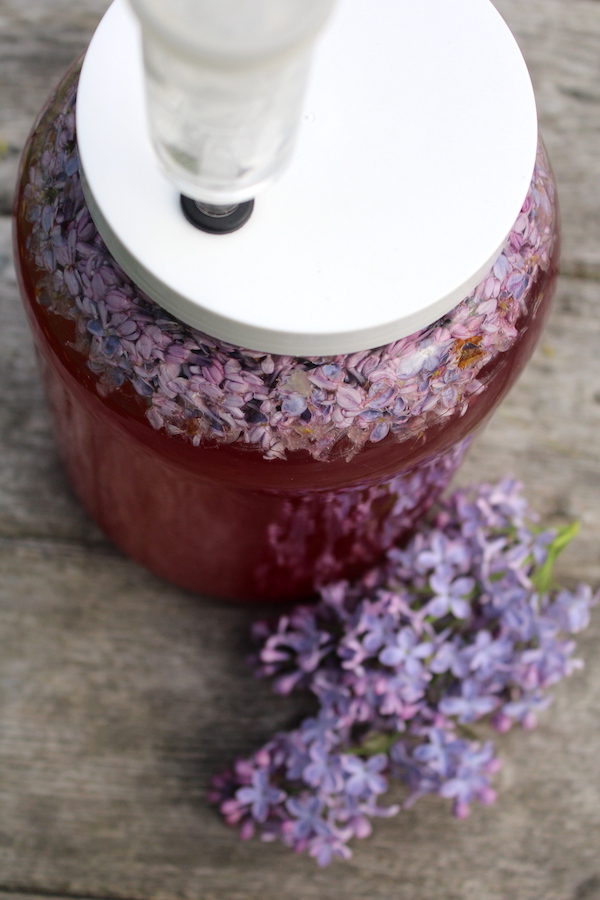
A brewing siphon really helps with this process and helps ensure everything stays clean and the sediment is left at the bottom for a clearer wine. Lacking that, careful pouring gets the job done, although much less elegantly.
All you really need equipment-wise is a fermentation vessel and water lock, and then bottles, wine corks, and a bottle corker. Everything else is just nice to have, but not a must.
Now the wine needs more time to clarify and for the yeast to finish their work. Allow the wine to ferment for at 2-3 months in secondary. Longer works too, and up to 6 months is great if you’re patient.
Just make sure you keep an eye on the water lock and don’t allow all the water to evaporate. If you rack the wine again at some point, it’ll improve the clarity of the finished wine.
When you’re ready to bottle, siphon the wine into sterilized wine bottles and cork it up. Allow the lilac wine to bottle condition for at least 6 months before drinking. All in all, you’re looking at 9 to 12 months start to finish, so you’ll be drinking this lilac wine when next year’s blossoms arrive…
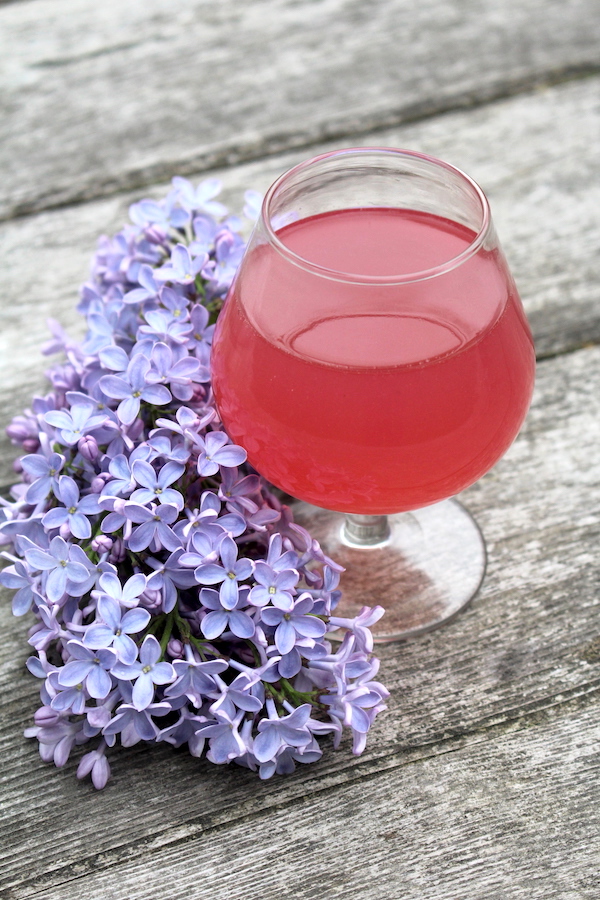
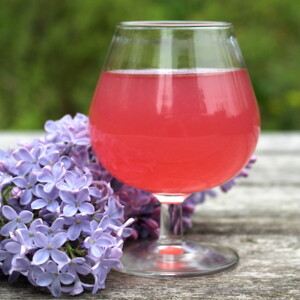
Lilac Wine
Ingredients
- 6 cups lilac blossoms, stems and green parts removed
- 5 1/2 to 6 cups sugar
- 1 handful blueberries, optional, for color
- 3 to 4 medium lemons, juiced
- 1 tsp yeast nutrient
- 1/8 tsp tannin powder, optional
- wine yeast
Instructions
- Clean lilac blossoms, removing everything but the actual flower. Place them in a fermentation vessel.
- Bring 2-3 quarts of water to a boil on the stove, add sugar and a few blueberries (optional). Stir to dissolve the sugar. Allow the syrup to cool completely before proceeding. It can help to do this part first, then start cleaning the blossoms.
- Pour the cooled syrup over the lilac blossoms, add lemon juice, yeast nutrient and tannin powder (if using).
- Fill a small cup with water and add the wine yeast. Allow the yeast to rehydrate for at least 5 minutes before adding it to the wine (adding it directly can shock the dormant yeast).
- Cap the fermenter with a water lock and allow the mixture to ferment in primary for 7 to 10 days, cleaning out the water lock if necessary.
- After primary, use a siphon to rack the wine into a clean fermenter, leaving the flowers and sediment behind.
- Ferment in secondary for 2-3 months (or up to 6 months) before bottling. Racking again during this time will result in a less cloudy finished wine.
- Bottle in wine bottles and store in a cool, dark place. Allow the wine to bottle condition for at least 2 months, but preferably 6 months before drinking.
Nutrition
Nutrition information is automatically calculated, so should only be used as an approximation.
More Home Winemaking Recipes
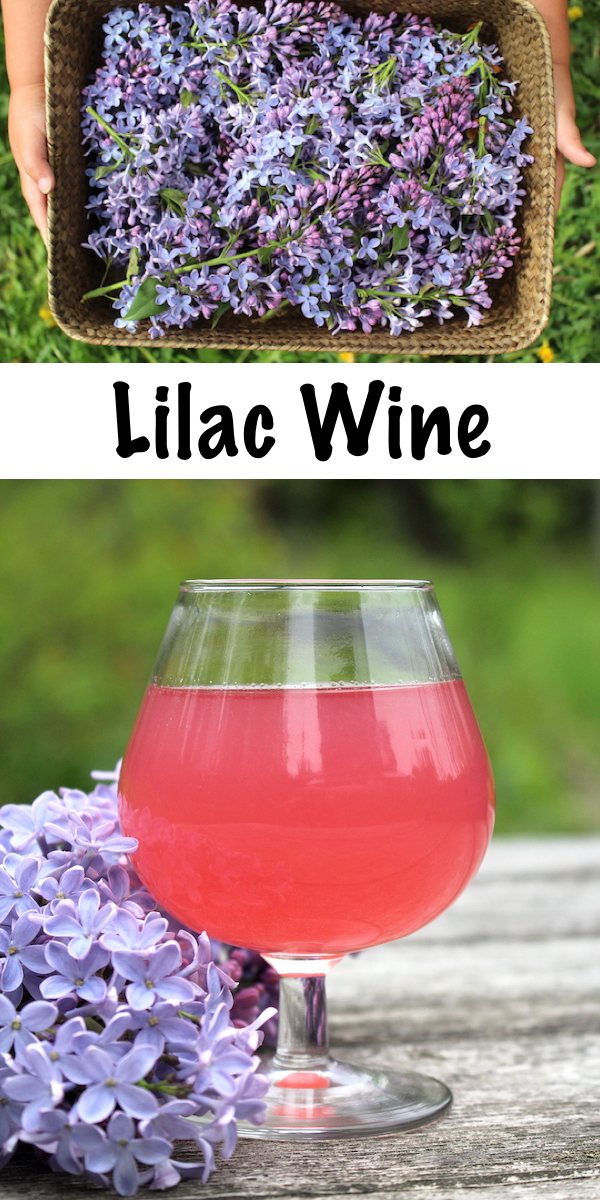


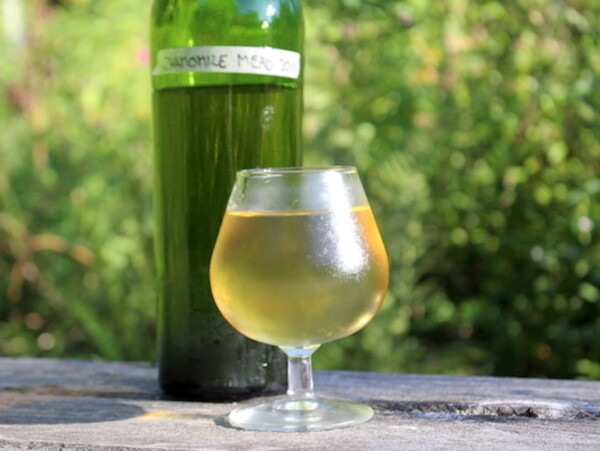
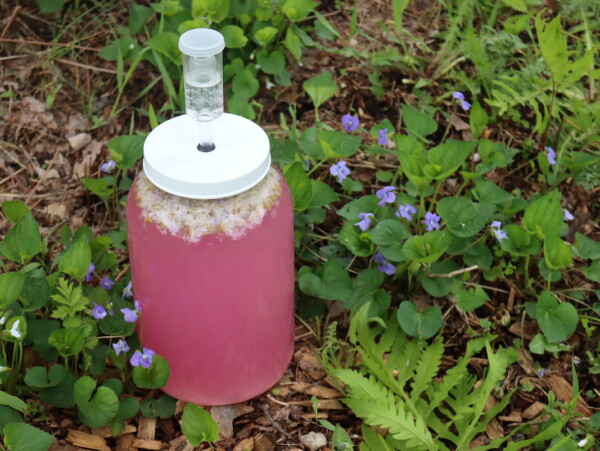
Just complements. I am now in my 70s and make wines from at least 25 different flowers over the decades. A lot of what you do mirrors what I do. I am glad there is someone else out there. I am near the end of the end. As I said, I make at least 25 different wines from flowers & another 25 different wines from fruits including mango & dates & figs and once upon a time I would make 25 gallons or so of rhubarb wine each year. This year I have made black locust wine (exquisite) and dandelion & 9 gallons of lilac & today I just put together 3 gallon of red double Rosa rugosa. I also have the yellow Harrison roses that make a nice wine & the old fashion double pink roses but not this year. I still have plenty down in my wine cellar. Wish you all the best & appreciate you efforts to share you knowledge. P.S. Violet wine is exquisite.
That is so good to know! I’ve made many of those, but black locust is still on my list. Our black locust jelly was amazing! I believe you when you say it’d make a great wine!